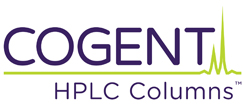Assay Method for Solarcaine® Gel Extract
This AppNote shows how Lidocaine Hydrochloride (HCL) from a gel extract can be easily analyzed. The compound has a tertiary amine but excellent Peak shape is achieved; which is often difficult to obtain for analytes like this.
A Gradient was used to ensure components from the gel extract matrix do not build up on the Column and adversely affect robustness or Column life. The Column robustness is demonstrated by the overlay of injections from two different Column lots.
Method Conditions
Column: Cogent Diamond Hydride™, 4μm, 100Å
Catalog No.: 70000-7.5P
Dimensions: 4.6 x 75mm
Mobile Phase:
—A: DI Water / 0.1% Trifluoroacetic Acid (v/v)
—B: Acetonitrile / 0.1% Trifluoroacetic Acid (v/v)
Gradient:
| Time (minutes) | %B |
| 0 | 97 |
| 1.5 | 97 |
| 6 | 40 |
| 7 | 97 |
Post Time: 3 minutes
Injection vol.: 2μL
Flow rate: 1.0mL / minutes
Detection: UV @ 220nm
Sample Preparation: 250mg Solarcaine gel containing 0.5% Lidocaine HCL was weighed in a 25mL volumetric flask. A portion of 50:50 Solvent A / Solvent B diluent was added and the flask was sonicated 15 minutes at 40°C. It was then diluted to mark and filtered with a 0.45μm Nylon Syringe Filter (MicroSolv Tech Corp.).
t0: 0.9 minutes
Note: Lidocaine is a local anesthetic used in a variety of applications such as sunburn relief and numbing for dental procedures. As such, several types of formulations are used such as topical creams / gels and injectable solutions. Trade names include Solarcaine and Xylocaine®.
Attachment
No 215 Lidocaine in Gel Analyzed with HPLC pdf 0.4 Mb Download File



